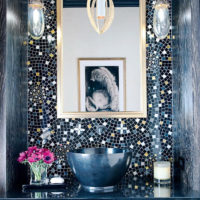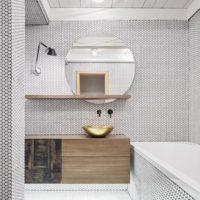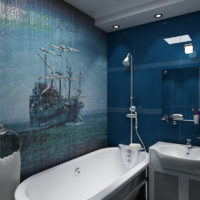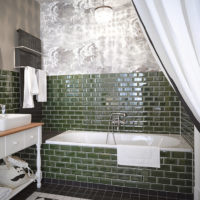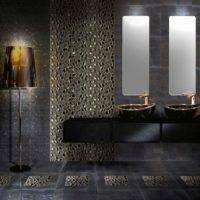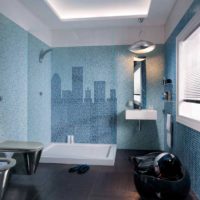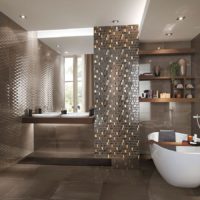The use of mosaics in the interior of the bathroom
The decoration of the bathroom is high. The surface should be moisture resistant, easy to wash, maintain its original appearance, despite high humidity, exposure to hot steam. These criteria correspond to the mosaic in the interior of the bathroom.
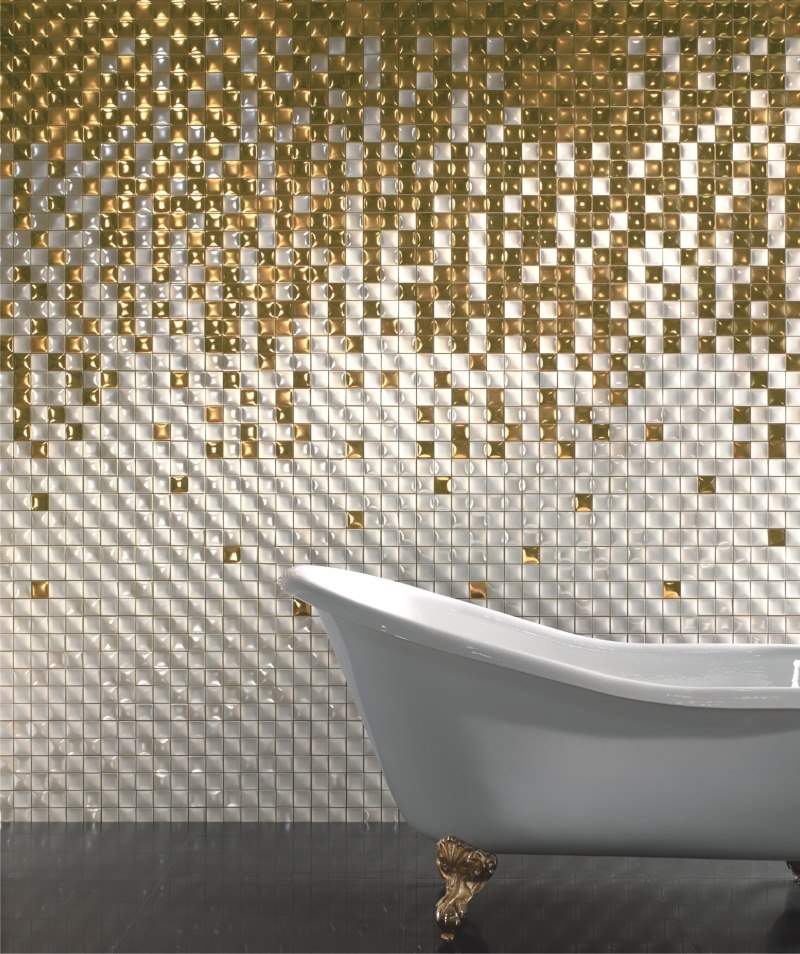
Mosaic will make the bathroom interior aesthetic in concept and luxurious in execution
Mosaic art, as highly artistic mastery, has been known for many millennia. This is the name for creating an image by laying out and attaching tiles of different colors from smalt, stones. For the first time, mosaic was used in the construction of palaces in Mesopotamia. There were used geometric shapes: rhombus, triangle. They were painted in red, white and black. In antiquity, mosaics were made from natural unprocessed pebbles. They depicted heroes of myths, people, animals. Dominated by ornaments on floral, geometric themes. Over time, styling and handling techniques improved.

The design of the bathroom is built on the unity of color shades or on contrasting solutions - it all depends on personal preferences and the desire to create a comfortable and organic atmosphere in the room
Content
Materials and shape
The construction industry produces mosaic tiles from the following traditional and new materials:
- natural and artificial stone;
- ceramics;
- porcelain tile;
- glass;
- metal.
Natural (granite, marble, onyx, jasper), artificial stone is often used for finishing floors. The stone has the greatest resistance to damage, chemical attack, strength, durability, but it is quite expensive.

Stone mosaic is rough, smooth, square, round or in the form of fragments. And the color scheme just can not be listed.
Ceramics are valued for a wide selection of colors and shades, the ability to create a highly artistic work at relatively low cost.

Ceramic mosaic based
Glass is distinguished by ease of maintenance, but the application reduces the limited color palette, fragility. A variety is smalt, which is obtained by pressing colored glass with impurities. It is distinguished by a dull surface, but it glows from the inside.

Gold mosaic glass mosaic
A metal mosaic looks attractive, but is rarely used due to its susceptibility to corrosion in a humid environment. They are used only in spacious bathrooms for decorating individual elements farthest from moisture sources.
Porcelain tile is the newest of mosaic materials. It has low water absorption, excellent heat resistance and frost resistance. It is used for cladding floors, facades, park paths, sidewalks, decoration of fireplaces and stoves.

Porcelain mosaic tiles ideal for flooring
Recommendations for choosing a tile material:
| Material | Positive properties important for finishing in the bathroom | disadvantages | Suggestions for use for the bathroom |
| A rock | special strength and wear resistance; fire resistance; inertness to active media; low hygroscopicity; artificial stone has wider decorative capabilities. |
The high price of natural stone.Slightly lower cost of artificial. | Operational properties depend on the type of stone. Due to brittleness and high moisture absorption, limestone is not recommended for use in the bathroom. Stone mosaics perform the total cladding of walls, ceilings, floors, drawings, ornaments. |
| Ceramics | strength and wear resistance; does not conduct electric current; chemical inertness and hygiene with a glazed coating; decorativeness, color stability, wide color palette; the ability to create a highly artistic work at a relatively low cost. |
Total lining of walls, ceilings, floors, laying out drawings, ornaments. | |
| Porcelain Tiles | wear resistance; low water absorption; easy care; wide selection of colors. |
Total cladding of walls, ceilings, laying out drawings, ornaments. Most often used for flooring. | |
| Glass | beautiful appearance; low hygroscopicity; easy care. |
Layout of images. | |
| Metal | strength; special appearance. |
Susceptibility to corrosion | Decorative elements of the interior in places remote from the source of moisture. |

For the floor choose porcelain tile, tile or glass coating

Azure shades in the marine theme
Most often, a mosaic in the form of squares with a side of 1, 2 and 5 cm is used. In addition, mosaic tiles are produced in a rectangular, oval, rhomboid shape. For the calculation of the images take the smallest.
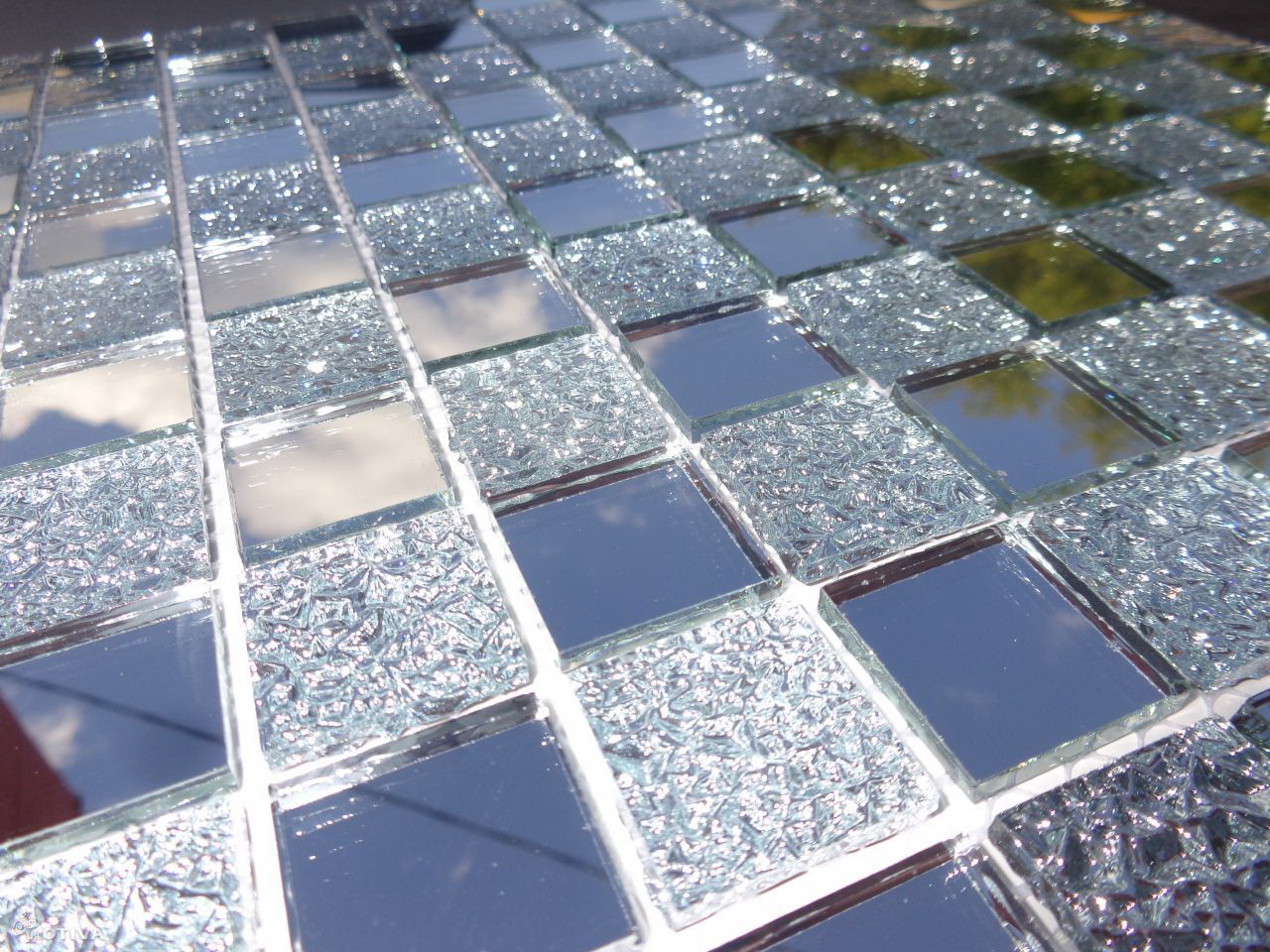
Mirror mosaic - a kind of glass, only with silver coating on the inside
Mosaic Tile Properties
She has all the positive qualities of the material from which it is made:
- moisture resistance, retains its properties with increasing temperature;
- strength and durability;
- firmly glues to concrete, wood, metal, plastered surfaces;
- it is convenient to clad uneven surfaces with a complex contour;
- various colors and shades.
In addition to the listed properties, the opportunity to create highly artistic ornaments, drawings, panels is valuable. In this mosaic can not be compared with any finishing material.

Mosaic is not afraid of water, easy to clean and resistant to cleaning agents.
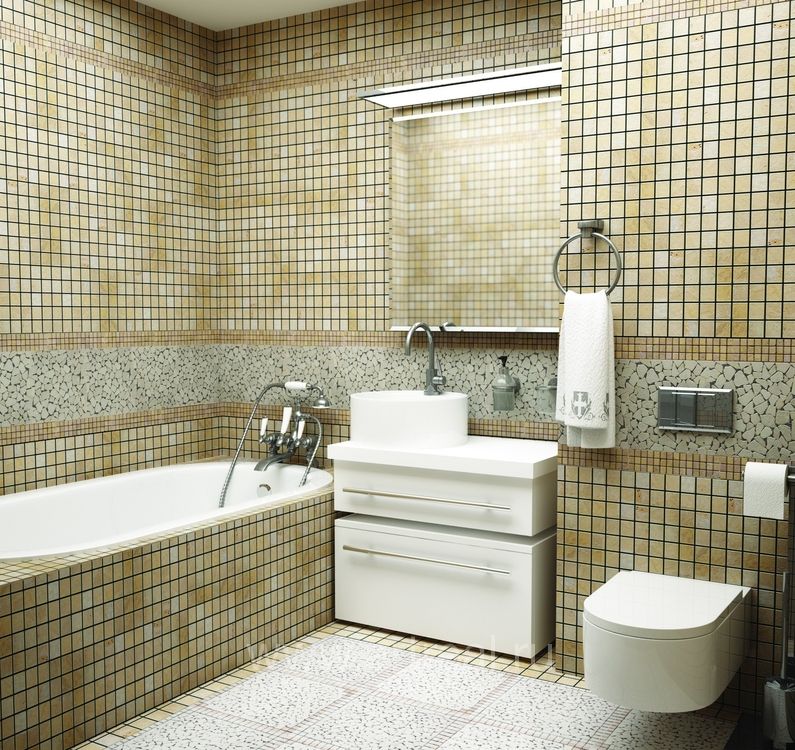
The mosaic-lined space seems lighter and more spacious.
The disadvantages include the high price and expensive services for laying mosaic tiles. Given the preservation of the original appearance for many years, finishing with this material is a profitable investment.
Technique and subtleties of styling
The technology for installing mosaics is similar to laying ceramic tiles. A special primer, a binder or adhesive for laying is also used, the base is prepared, cleaned and leveled, but there are some differences.

Mosaic Laying
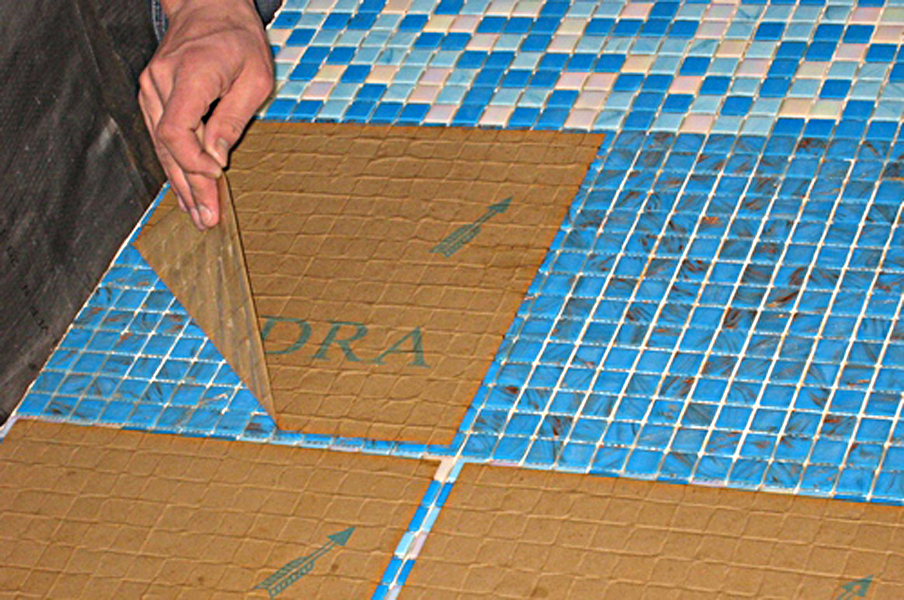
Paper based mosaic application
Distinguish between direct and reverse mosaic. With direct dialing, image elements are pressed into the bonding composition, glued to the grid. After drying, the mesh adheres to the base. In the reverse way of typing, the drawing is first formed on paper in mirror image. Then everything is transferred to a surface previously coated with adhesive. After drying, the paper is removed by pre-wetting with water.
When laying mosaic tiles, observe the following sequence:
- The surface is thoroughly cleaned of dirt, previous coatings, cleaned with sandpaper, primed.
- Marking is applied to the wall, they are oriented on it when laying out rows.
- Glue is selected that exactly matches a particular tile. It should be noted that dark glue will change the color of a translucent tile.
- The glue is applied to the wall using a fine comb.
- A grid with tiles is applied to the wall, straightened, pressed with the help of a special device. Make sure that the seams between the elements in the canvas and between the canvases are the same.
- The building level periodically checks the vertical and horizontal.
- After 1-2 days, when the glue dries, the seams are filled with the usual building grout. It is left white or painted in tone tiles.

For grouting glass mosaics using special epoxy compounds
Bathroom Finishes
In the interior of the bathroom mosaic is used:
- for the design of walls, ceilings, floors (continuous cladding or a set of panels, friezes, rugs);
- emphasis;
- zoning;
- creating aprons around the bathroom, washbasin, shower;
- finishes for countertops, niches, built-in furniture.

Flexible mosaic tiles can be laid out on surfaces of complex shape

Mosaic countertop in the bathroom
When developing the interior design of a bathroom with a mosaic, the following should be considered:
- In small bathrooms, where in addition to the bathroom the toilet is located, using mosaic tiles to visually expand the space, indicate the zone. Separating the floor and walls with different mosaics, separate the functional areas. Material or color may vary. Framing elements, such as stripes, look spectacular.
- A fully tiled bathroom looks overloaded. Therefore, it is recommended that one or two walls be made plain.
- Rectangular mosaic tiles arranged horizontally look beautiful. They look original, but discreet.
- If the wall opposite the large mirror is laid out with small elements, the room will seem more spacious. The space visually expands if the wall of saturated color is opposite the light one.
- It is convenient to finish round surfaces with a mosaic. So you can highlight the bath, wash basin, niches, shelves.
- Mosaic tiles look beautiful in combination with a glossy ceiling, LED lighting.

Mosaic is great for refining such uncomfortable structures as engineering boxes. Small tiles are easy to fit to any surface.
Drawings, ornaments, paintings
From mosaic tiles, as well as many hundreds of years ago, beautiful pictures and panels are laid out. For bathrooms, pictures of the marine theme are appropriate.

In the interior of the bathroom, combinations of tiles with mosaics are often used.

From the mosaic you can put almost any pattern, art image or original ornament
To finish the bathroom, take ready-made blocks with a pattern or apply a mosaic according to the design. Often, floral motifs, geometric or floral ornaments are chosen as the basis. They transmit the energy and freshness of nature. Even simple coupon stripes along the plinth or in the corners become a bright accent, give the interior a uniqueness.
Mosaic decoration is painstaking work, it takes a lot of time, therefore it is often combined with ordinary ceramics. Against the background of the monophonic basis of the walls, floor, and ceiling, the mosaic will look more impressive.

Chic mosaic pattern above the sink

Bath screen cladding in a classic room interior
Color selection
When choosing a color scheme, you should focus on the general concept of the design project and the tasks that should be solved. In this case, the following nuances should be taken into account:
- Mosaic, sustained in soothing colors, devoid of variegation, creates a calm, peaceful atmosphere, makes the decoration unique.
- One color can be selected or a transition from one shade to another, and there can be dozens of shades. The rule works: in small rooms, the dark color at the bottom gradually turns into a light top. For spacious rooms, vice versa.
- The combination of several shades in a chaotic order is a pixel mosaic.
- A plain wall looks interesting if elements with a pearly sheen form a pattern on a matte background of the same color.
- The interior becomes bright and unusual when using panels. They are now being sold already glued to a fiberglass mesh. It remains to fix the finished picture on the wall.She is the dominant accent. The background is better to choose a more calm, solid.

The interior of the bathroom, designed in a single color scheme

It is important to combine the colors of the mosaic with plumbing and decorative elements of the bathroom
Most often, for bathrooms, designers choose blue, white, lime, pastel colors. For larger rooms, more saturated and even darker colors are used. Cream, pink, orange, azure, lilac, and violet go well with white. Such combinations relax and soothe, avoiding the sensation of an operating room.
The combination of white and gray looks faded and dull, but it can be diluted with green. The combination of white with black or red highlights certain details.

Using the mosaic, you can highlight the accent wall
Mosaic gives the interior sophistication and luxury, if the design is thought out in advance, the material and all the shades of the color scheme are correctly selected.
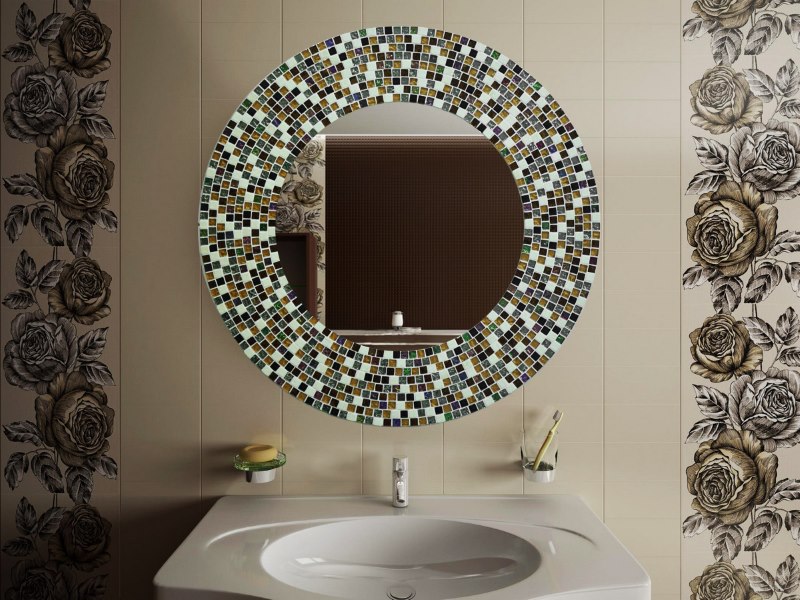
Even a small mosaic pattern can bring the bathroom design to a completely different level
It is good to relax in such a bath after a busy day. Mosaic tiles are moisture resistant and durable, the bathroom does not require repair for several years. Mosaic is the best solution for creating a stylish bathroom interior, where you can start the day with a good mood.
Video: the intricacies of DIY mosaic styling
Photo: mosaic in the interior of the bathrooms









